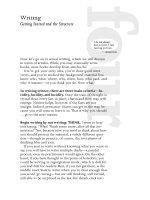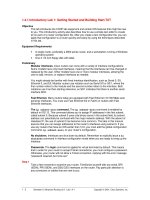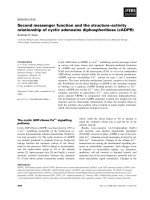Writing - Getting Started and the Structure
Bạn đang xem bản rút gọn của tài liệu. Xem và tải ngay bản đầy đủ của tài liệu tại đây (152.61 KB, 26 trang )
f
o
ur
Now let’s go on to actual writing, which we will discuss
in terms of articles.While you may eventually write
books, most books develop from articles. So:
You’ve got your story idea, you’ve done good inter-
views, and you’ve studied the background material.You
know who, what, where, why, when, how, who paid, and
why it matters—or you think you do. Now what?
In writing science, there are three main criteria—lu-
cidity, lucidity, and lucidity. Once the train of thought is
crystal clear, every fact in place, charm and flow may well
emerge. Neither helps, however, if the facts are not
straight. Indeed, premature charm can get in the way, be-
cause you will want to leave it in. That is why you should
. . . go to the next maxim.
Begin writing by not writing: THINK. I seem to hear
you saying, “What? Think some more, after all that im-
mersion?”Yes, because now you need to think about how
you should present the material, a subtly different ques-
tion—though in practice, of course, the two phases of
thinking blur and join.
If you start to write without knowing what you want to
say, you will have to write multiple drafts—a painful
process, even its practitioners would agree. On the other
hand, if you have thought to the point of boredom, you
could be writing in regurgitation mode, which is dull for
you and dull for readers. Best, if you can get there, is the
middle road: Start to write when you’re clear enough that
you won’t go wrong—but are still thinking, still excited,
still able to be surprised as the last few details click into
Writing
Getting Started and the Structure
I do not always
love to write. I love
having written.
—Anonymous
place. If you think while you write, you will enjoy it more
and your prose will be more muscular and engaging.
If you have ever painted a room, someone surely told you
the old painter’s adage: It takes more time to get ready than
to paint. And you surely found it true: patch the holes in the
plaster, sand the woodwork, sand the patches, vacuum up all
that fine grit, find a hole you missed, patch the hole, vacuum
up all that fine grit, put masking tape along the window glass,
go buy more tape, tape more windows . .. By the time you lay
down drop cloths and discover that you have only semigloss,
it’s time for dinner and you haven’t even wet a paintbrush.
Yes, but the next morning you do the whole job in three
hours, and there’s no need to razor the windows or scrub
paint off the floor. And it’s the same way with writing.
Think about the readers, emphasis readers, plural. Read-
ers come in clusters. There is never only one, though one
will be central. When you write, you will address that key
reader directly, thereby rousing your social skills. The other
readers will listen in and benefit from the occasional aside
(or joke, or whatever) that you tuck in for their benefit.
When I write, I can almost see my readers, a ghostly
crowd installed in my head by the city editor of the Corning
Leader, the newspaper of Corning, New York. I was the new,
young “wire editor,” hired to sort through the national and
international news that the Associated Press still sent by wire,
then decide what news to put on the front page (and only
the front page, because local news and the grocery pages
were why people bought the paper). The city editor was
giving me a one-minute training.
News included the doings of President Nixon and the war
in Vietnam, of course, and I was to remember that some
people got all their news from the paper. I was to squeeze in
all the highlights.
But world events were just a start. “People like to laugh,”
said Walt. If something amusing came through, I was to
use it.
And “Most of our circulation is on the rural routes,” said
Walt. “They’re farmers. So anything that matters to agricul-
ture, that’s news.”
Then there were the vineyards at the nearby Finger Lakes.
“Because we have vineyards, we have Italians,” said Walt.
“And they’re Catholic. So anything the pope does, that’s news.”
Ideas
into
Words
70
And, finally, it was winter. February, as I recall. “At this time
of year,” said Walt, “people get tired of snow. Now, you’ll no-
tice that the AP sends through a picture of girls on the beach
in Australia almost every day. Save the good ones. I want to see
one of those pictures on the front page about once a week.”
After that masterly briefing, Walt and I got on pretty well,
except the day when I put the death of Janis Joplin on the
front page, top left. The sordid death of some rock star was
not news! screamed Walt, scarlet with rage. “It is to our young
readers,” I mumbled.
So: one front page, many readers. One book or article,
many readers. One magazine, many readers.
From that viewpoint, your goal in writing is to capture
and serve as many different readers as possible, yet stay fo-
cused on the core concern shared by the subgroups. You
directly address the key reader, offering 100 percent of what
that person needs (e.g., rudimentary world news). Then you
throw the others a bone whenever one comes to hand (corn
blight in Ohio, Pope visits Venezuela, Janis Joplin dies). I am
going to discuss one example in some detail, in the hopes of
infecting you with a good feel for how to proceed.
Identifying the core reader is a crucial decision, one that
needs thought. Suppose you have an assignment to write
about infant vaccination for the Johns Hopkins Magazine, whose
readers are Hopkins alumni. Most have advanced degrees,
many are medical or scientific professionals, and those older
than forty are predominantly male. As a whole, do they have
any personal need for information on vaccination? No. The
group includes young parents, but they do not expect pedi-
atric advice in their alumni magazine. It’s similar for alumni
physicians: they go to journals and conferences for their
medical updates. Anyway, both parents and docs need detail
that you could not sensibly inflict on other readers.
So your article might best address the educated curious—
who I would argue constitute the core readership for almost
all science writing (other than self-help). But only the very
curious, such as the Elephant’s Child (who wanted to know
what the crocodile ate for dinner), are curious about any-
thing and everything. Most people care only about things
that affect or might affect the world they live in.
On that basis, try visualizing the core reader as some-
one—any sex, any age, anywhere—who might have an effect
Writing
and
Structure
71
on public health policy: a senator’s aide, perhaps, or the sen-
ator herself. If you offer this person a solid translation of the
new scientific material that a policymaker ought to know,
the article will automatically call up most people’s sense of
might-affect-me. It will be relevant.
The key issue, in this case, is herd immunity to disease:
the idea that if almost all of the group are immune, even the
unvaccinated few are safe because they never get exposed—
how could they? Everyone else has been vaccinated.
If you can deliver that concept so fast that the reader gets
it at a glance, your policy wonk will stop flipping pages—ah
yes, this could be important. So, how much of the herd must
be immune, under what circumstances? Some babies react
badly to some vaccinations, he has heard—what percentage?
Of which vaccinations? (Make sure you find the latest fig-
ures.) How do those numbers stack up against babies saved
from major infectious disease? Is the U.S. population as a
whole sufficiently vaccinated against infectious disease? Is
there any good argument not to vaccinate? Does the possibil-
ity of biological terrorism change the picture? You can see
how the article would develop.
For a stark contrast, now suppose you have an assignment
from Family Circle to write advice about vaccinating baby.
Family Circle amounts to a professional journal for women
building homes and families, so its readership is relatively
narrow.You can bet that almost everyone who reads the arti-
cle will be a young mother who wants to become a better
mother: your key reader.
Now step into that woman’s shoes. Ask yourself, If I were a
young mother with a new baby, what would I want to know
about vaccination? What would I already know? What misin-
formation might I have? What might I be afraid of? How re-
alistic is that fear? What must I know, to make good deci-
sions? Your article will need to address all those issues, in
language accessible to the reading public at large—let’s say, a
person with a high school education (but smart, never for-
get—she’s smart).
This woman may have an interest in public policy, but her
overriding concern is how to do the best for her own baby.
Obviously, your discussion of herd immunity will be radi-
cally different from the piece you wrote for Hopkins; you’ll
be spelling out the trade-offs in terms of individual risk.
In addition, the key reader will have a more sophisticated
Ideas
into
Words
72
sister, who may only skim your article because she read
about herd immunity some years back. So she thinks she
knows . . . but you’ve found some new and important infor-
mation about particular vaccines. Can you think of some way
to highlight the new stuff for a skimmer? (Yes, put it in a
box.) She may have more sophisticated questions, too. For
example, Does it help to postpone some but not all of the
usual infant vaccinations? If so, which ones? If the mother is
nursing the baby, does that make a difference? Not all the
readers would have thought to ask those questions, but they
will all care about the answers.
Then consider the pregnant reader. Since nursing helps the
baby, she needs to know it now, while she’s deciding
whether to nurse. Is there anything else she needs to know?
Even more important, imagine a young mother who reads
with difficulty. She is struggling to read your article only be-
cause she is worried—a neighbor said vaccination might
hurt her baby, and then she happened to see the cover blurb
in the grocery store. That final reader constitutes a small but
critical audience: critical because she and others like her do
not normally read magazines and newspapers. Basically, your
article may be her only source of information. For this
reader, you might take special care to state each key point
simply, perhaps in boldface, before you elaborate.
So far as I know, no such pair of articles exists, though
herd immunity does. I picked Family Circle because it is an ex-
cellent source of basic medical information, translated out of
medical jargon yet helpfully specific. The editors serve their
readers well.
The take-home lesson is that, for any topic and any publi-
cation, you should hold in mind a central reader, along with
a cluster of others who have somewhat different needs and
backgrounds.Whenever you get a writing assignment, ask
the editors to tell you about their various readers.
As you start to think through a piece, imagine yourself as
each reader in turn.Who are these people? What does each
one need and expect from you? What will each group want
to know? If you meet one particular reader completely, will
that do most of the job for the others? Yes, that’s the primary
one, the reader. Knowing the reader early on will help you
decide how to approach your article, and later it will help
you choose vocabulary, examples, and analogies.
Writing
and
Structure
73
In general, the readers of serious nonfiction are intelligent
and curious, but otherwise varied—old, young, male, fe-
male, East Coaster, Californian, Midwestern, with and with-
out various levels of education and background. Any given
article might even reach a few specialists, checking to see
what the general public is reading. (Though tiny, this group
is important to you because they will remember your name
if you appall them.) At the opposite end of the spectrum falls
a group that you might encapsulate as eighth graders gather-
ing clippings for a class project in science—future readers, as
it were. Most readers fall somewhere in the middle, having at
least some college education. The dominant trait that all
share is curiosity.
The difficulty is that “some college education” leaves little
common ground. The days are long gone when all undergrad-
uates took a foreign language and four semesters of science.
The readers who did take college chemistry may remember
little, or wrongly, or what they remember may be outdated.
Even people with PhDs in other sciences probably know little
to nothing of any particular topic outside their field.
Bottom line: any background information that the readers
need you must supply—in such a way that you appear to be
only reminding them, or that the better-informed readers
can easily skip.
Think about the subject matter and mark your material
for use in writing. With your reader(s) held in mind, re-
view all your notes and printed matter so that all is fresh in
your mind, seen as a whole. If you are writing a brief news
item, such a review may take fifteen minutes. For a major
feature, it may take several days. Relax:You will get the time
back when you write. Just keep combing through. (You can
see why immersion and planning tend to blur.)
Now that you’re no longer struggling to understand, the
pondering phase is fun, a time when you get the payoff for
the asterisks, comments, and questions you left for yourself
in your notes. I almost always find unexpected gems in the
early interviews, facts and comments that I had forgotten or
hadn’t known enough to savor at the time.
To write a long piece, you’ll want to leave yourself a trail
back to any quotes and facts you need, without hours of
rummaging. So whenever you find a gem, something you
will want to use, write a yellow sticky and place it in the
Ideas
into
Words
74
margin, poking out. Soon your books and notes will fairly
bristle with stickies saying things like “Feynman paint story”
or “Good e.g. protein folding.” Later, as you write, you’ll be
able to move right along, maintaining a forward momentum
that will keep the piece lively.
Before you start to write, write a head and subhead—
good ones, not perfunctory. The process will force you to get
precise about both topic and approach.
As a unit, the heads have two jobs: to lure the readers in
and to constitute a fair billing. Consider pheromones, the
chemical signals with which animals (including us) attract
mates—moth pheromone does nothing for rutting bucks
and vice versa. In the same way, the allure of your headline
should speak specifically to the right readers, the cluster of
people you are talking to. Obviously, the articles for Hopkins
and Family Circle would carry very different heads.
To write headlines, imagine your flock of readers sitting
across the desk and ask yourself, “What am I really trying to
say?” Then start typing, brainstorming with your keyboard.
Don’t worry about whether you’ve got anything good. Just
keep at it till you generate a flow. Something like this:
THE MUMMY’S TALE
What mummies tell us about their life and times
What mummies tell us about their lives and times
What a mummy can tell us
Diagnosing from 3,000 years away: a Swiss doctor
...
Was acupuncture used in ancient Europe? Oetzi’s tattoos say
maybe so.
CHECK SPELLING
Was acupuncture used in ancient Europe? A mummy’s tattoos
say maybe so.
Was acupuncture used in ancient Europe? Mummies cast
light on this and other questions.
Acupuncture in ancient Europe? Maybe so. Mummies
reveal all.
Acupuncture in ancient Europe? Neanderthal civilization?
Mummies can still speak.
Mummies can hint.
Mummies are full of silent hints.
Hints from Mummies
The Mummy’s Whisper
The Mummy’s Tale
Writing
and
Structure
75
Acupuncture in ancient Europe? Neanderthal civilization? Ask
a mummy. [EUREKA!?]
Acupuncture in ancient Europe? Neanderthal civilization?
ASK A MUMMY.
(Yes, the subhead can sometimes precede the head.)
And so on. Fill several pages.
In this case, I happened to get a workable head right away,
so I went straight on to subheads until a too-long subhead
produced a new candidate for headline.You can see I was
starting to get silly, often a good sign. Once you create a few
outrageous heads, you’ll be chuckling, and then you may do
a double take:Yeah, but actually, there’s something in that . . .
Brainstorm till you run dry and take a break.When you
come back, you’ll be able to assess which candidates show
signs of life.
It can help to show two or three headline combos to other
people—but do not ask them for suggestions unless they
know your material. Ask them which headlines make them
want to read. For each one that has allure, ask what they ex-
pect from the article. Then ask yourself, Is that roughly what
I plan to deliver?
If your most alluring heads keep dwelling on some part of
the topic you were not planning to emphasize, you might
want to reconsider.Your subconscious (i.e., your muse) may
be trying to tell you something.
If it’s not written down, you don’t have a plan. Make a
plan, following the advice once given by Alexandre Dumas
père for three-act plays: The beginning (first act) should
be clear, clear, clear; the middle (second act) should be
interesting, interesting, interesting; and the end should be
short, short, short.Your written plan may be very simple,
especially for something short: head and subhead, idea for
the opener, idea for the closer, plus a list of three to five
major points you want to make in between. I often write
from that little. Others make elaborate outlines.
You will need to experiment and see what works for
you—probably some version of however you wrote as a
child. Did you make detailed outlines, as the eighth-grade
teacher said to do, and it worked? Or did you write, then
produce the outline later, since the teacher wanted to see
Ideas
into
Words
76
one? Or were you somewhere in the middle? Maybe you
outlined the main points before you wrote, but filled the rest
in later for the teacher?
Wherever you stood in that spectrum, you are the same
person now, albeit using bigger words. So the same approach
will likely be congenial.
If making and using detailed outlines is your natural way, I
suggest you think through organic structures as discussed in
the next few pages. Make an outline that will execute the
shape you found inherent in your material, with special at-
tention to the opener and closer. Then write.
If you are more of the intuitionist school, you can skip the
outline, but do write the heads and list your three to five
major points. Then plunge right in: write the opener.
The opener: Imagine your readers, ask yourself what you
want to tell them, and start typing. Keep taking a run at it,
brainstorming with your keyboard, much as you saw me
doing with heads and subheads, until suddenly something
feels right. The approach just . . . fits.You know it’s a Yes even
before you see why or where to go next, and the imaginary
reader(s) in your mind will be nodding, eager to hear what
comes next.
An opener should follow seamlessly from the head. It
should rivet the reader, establish rapport between reader
and writer, and strike into the heart of the story—all in a
single paragraph, if the piece is very short, say fewer than
five hundred words. For a New Yorker–style piece, as many as
six paragraphs will be okay, but the first paragraph still has to
be riveting. Aristotle’s advice, to begin in medias res (in the
middle of the action), has been helping writers for two
thousand years now, and it will help you, too.
Some people write the body of the text first and save the
opener to write last, to benefit from all the clarity that the
writing brought. If that works for you, great.
Others find (and I am one of them) that by not going on
till we get the opener right, we gain a clarity that shows up
in the whole rest of the piece. For me, the opener is a sub-
structure, a footing that must be in place before it feels safe
to erect the building. Since I began doing it that way, I spend
more time writing the opener, less time writing the body of
the piece, and less time overall.
Writing
and
Structure
77
It will help you to have the closer in mind as you write
the opener, for though you may later change your mind, you
must still embark in a specific direction.
The best openers are extremely specific, even concrete.
They grab hard and then move immediately into exposition,
four to six paragraphs worth, that is above all clear. Consider
this first paragraph from “Cooling the Lava” in The Control of
Nature (Ferrar Strauss Giroux, 1989) by John McPhee:
Cooling the lava was Thorbjorn’s idea. He meant to stop the
lava. That such a feat had not been tried, let alone accom-
plished, in the known history of the world did not burden
Thorbjorn, who had reason to believe it could be done.
He meant to stop the lava. Audacious!!—and totally clear. Already,
I am well and truly hooked. Now you’d have to bore me for
several pages before I’d quit, so McPhee has plenty of time to
exposit Iceland’s economic dependence on Heimaey, the
country’s only harbor, and to describe Thorbjorn’s early ef-
forts when an emerging volcano threatened to fill that har-
bor. But imagine if the piece had started with the third para-
graph: “Heimaey is pronounced ‘hay may.’Vestmannaeyjar is
more or less pronounced ‘vestman air.’ The town on
Heimaey is the only place in the archipelago inhabited by
human beings, . . . ”
Here’s another opener, by Cullen Murphy, from “Lulu, Queen
of the Desert” (The Best American Science and Nature Writing, 2000,
reprinted from the Atlantic Monthly), which relies largely on a
fillip of surprise, even exoticism:
Julian Skidmore is lithe and petite, with small wrists and
delicate features, and a serene but determined counte-
nance.Watching Skidmore at work for a while, her auburn
hair held back by a blue ribbon, a glint of light catching the
small pearl in each earlobe, I was reminded of Gainsbor-
ough’s portrait of the young Georgiana, Duchess of Devon-
shire. Then Skidmore removed her left arm from a camel’s
rectum, peeled off a shoulder-length Krause-Super-Sensi-
tive disposable examination glove, and said, “Can I make
you a cup of coffee?” She had completed eight of the
morning’s sixteen ultrasound scans. It was time for a break.
Skidmore, an Englishwoman known to everyone as Lulu,
has emerged during the past few years as among the fore-
Ideas
into
Words
78









